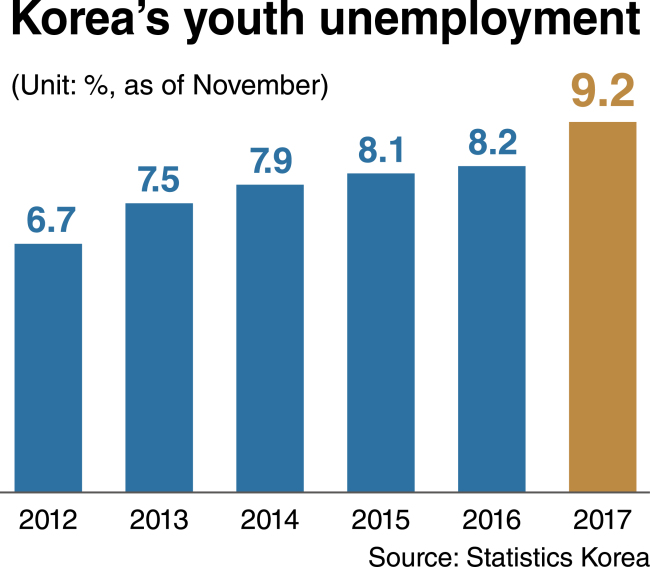Concerns are deepening that the country’s employment conditions will continue to worsen this year, leaving young job seekers frustrated and forcing mostly low-wage employees out of work.
In his New Year’s message, President Moon Jae-in vowed to place top priority on improving people’s livelihoods.
Critics were quick to note his pro-labor and anti-business policies stand in the way of creating more jobs, which hold the key to enhancing the quality of life.
A sharp hike in the minimum wage, coupled with a planned reduction in work hours and extension of the scope of ordinary wages, are set to increase labor costs in the coming years.
 |
(The Korea Herald) |
Many small and medium-sized enterprises find it challenging to absorb additional wage costs and are scrambling to cut their payrolls. About 40 percent of such enterprises cannot pay interests with operating profits, according to a survey by the Korea Federation of SMEs.
Self-employed businesses, most of which struggle to stay afloat, are driven to dismissing part-time workers or closing down.
Meanwhile, large companies will see their competitiveness weaken due to measures to raise the maximum corporate tax rate from 22 percent to 25 percent and reduce tax breaks on investments in research and development. Additional costs to be paid by local companies this year alone are estimated to reach 83 trillion won ($77.8 billion).
Despite its emphasis on innovation-driven growth, the Moon administration has shied away from carrying out sweeping regulatory reforms.
In a recent meeting with reporters, Park Yong-man, chairman of the Korea Chamber of Commerce and Industry, expressed worry that the “walls of regulations” would put Korea behind China in the process of the “fourth industrial revolution.”
Amid the deteriorating business environment, local firms remain reluctant to draw up plans to increase investments and employment.
Unfavorable employment conditions were reflected in the 2018 economic policy direction announced by the government last week, which forecast the on-year increase in the number of employees would reach 320,000 for the year, the same as the estimated figure for last year.
 |
(Yonhap) |
Excluding more than 50,000 jobs to be created in the public sector this year, the number of new employees will drop considerably from the 2017 figure.
In 2018, the Moon administration plans to spend 19.2 trillion won financing various job creation programs and an additional 3 trillion won helping small businesses with less than 30 employees pay the higher minimum wage.
Song Won-geun, a researcher at the Korea Economic Research Institute, a private think tank, said the government’s employment target will prove hard to achieve given job market conditions.
“The most urgent task is to forge an environment that will galvanize corporate activity,” he said.
Without a significant increase in well-paid corporate jobs preferred by young job seekers, the country’s youth joblessness problem can hardly be expected to be eased.
In recent months, youth unemployment has continued to hover around its highest level since the late-1990s foreign exchange crisis, embarrassing the Moon administration, which has vowed to prioritize job creation.
Economists note it would help ease the widening job mismatch among well-educated youths to push for labor reforms to narrow the gap in wages between large and small companies and between permanent and temporary workers.
The shrinkage of the country’s working-age population in the coming years is unlikely to reduce youth unemployment.
According to a recent report from the Employment and Labor Ministry, the number of Koreans aged 15-64 is projected to decrease from 36.48 million in 2016 to 34.3 million in 2026.
But the number of people with college diplomas is forecast to increase by 3.32 million, as most high school graduates enter universities or other institutes of higher learning. Furthermore, the population aged 25-29 is projected to grow by 390,000 over the years through 2021.
Economists worry that the deterioration of domestic business conditions will push more companies to move abroad, further reducing job opportunities at home.
A recent study by KERI projected a reversal of corporate tax rates in Korea and the US may result in an annual loss of about 100,000 jobs here over the coming decade, with corporate investments in the country decreasing 4.9 percent on average annually during the same period. The US Congress late last year passed a tax reform bill that lowered the corporate tax rate from 35 percent to 21 percent.
An increasing number of small and mid-sized firms are following large companies in transferring factories abroad. This move will severely aggravate employment conditions in the country, where SMEs hire 87.2 percent of workers. The proportion is far higher than 41.3 percent in the US, 52.8 percent in Japan and 63.3 percent in France, according to data from the Organization for Economic Cooperation and Development.
Figures from the Bank of Korea showed investments by local SMEs overseas increased 20 percent from a year earlier to $5.62 billion in the first nine months of 2017.
Calls are now growing for the Moon administration to ease the burden on companies and accelerate deregulation to prevent the aggravation of employment conditions.
Eo Soo-bong, chairman of the Minimum Wage Commission, said in a recent interview with local media that Moon needs to ditch his campaign pledge to raise the hourly wage floor to 10,000 won by 2020.
In July last year, the commission, consisting of representatives from the government and management and labor circles, decided to increase the minimum wage to 7,530 won in 2018, up 16.4 percent from 2017.
Economists say the Moon administration should be ready to change its policies that have increased corporate costs if employment data remains weak in the first quarter, when it plans to spend 34.5 percent of the budget allocated for job creation this year.
By Kim Kyung-ho (
khkim@heraldcorp.com)









![[Weekender] Korea's traditional sauce culture gains global recognition](http://res.heraldm.com/phpwas/restmb_idxmake.php?idx=644&simg=/content/image/2024/11/21/20241121050153_0.jpg)